INSTITUT SUPERIEUR D'ANTHROPOLOGIE
INSTITUTE OF ANTHROPOLOGY
ONLINE COURSES / COURS A DISTANCE
INSCRIPTION : Année Universitaire 2012/2013
REGISTRATION : Academic Year 2012 / 2013
ROYAUME UNI – 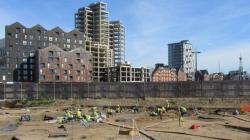
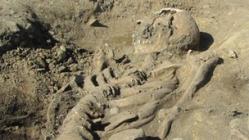 Ipswich - An archaeological dig at Ipswich waterfront has unearthed 300 skeletons and evidence of an old church. It is believed the Saxons occupied the site in the 7th Century and burials are believed to have taken place there until the 16th Century. Rubbish pits were also uncovered during the dig, led by Oxford Archaeology and Pre-Construct Archaeology. Seventh Century burial mounds have been found at one end of the 2.8 acre (1.15 hectare) site, while the 9th/10th Century church and its graveyard were found at the other end. Helen Webb, who is overseeing the study of the skeletons, said: "We're got the full range of ages, but it's the normal cemetery population with lots of the very young and very old dying. The graves have already revealed cases of leprosy and syphilis, but no jewellery or other artefacts have been found.
Ipswich - An archaeological dig at Ipswich waterfront has unearthed 300 skeletons and evidence of an old church. It is believed the Saxons occupied the site in the 7th Century and burials are believed to have taken place there until the 16th Century. Rubbish pits were also uncovered during the dig, led by Oxford Archaeology and Pre-Construct Archaeology. Seventh Century burial mounds have been found at one end of the 2.8 acre (1.15 hectare) site, while the 9th/10th Century church and its graveyard were found at the other end. Helen Webb, who is overseeing the study of the skeletons, said: "We're got the full range of ages, but it's the normal cemetery population with lots of the very young and very old dying. The graves have already revealed cases of leprosy and syphilis, but no jewellery or other artefacts have been found.
http://www.bbc.co.uk/news/uk-england-suffolk-19507960
USA – 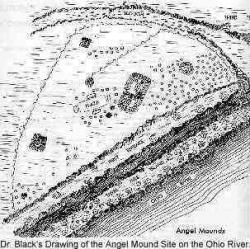 Angel Mounds - A new project will recreate how laborers for the Works Progress Administration uncovered the ruins of a Native American city while building public works projects in southwest Indiana during the last years of the Great Depression. WPA workers unearthed 2.3 million artifacts during a three-year period at Angel Mounds. The city of as man as 500 houses, which was surrounded by a stockade thousands of feet long, is believed to have been occupied from about A.D. 1100 to 1450. It is believed to have been part of the Mississippian Culture, a network of mound-building Native Americans in what is now the Southeastern United States. WPA workers unearthed some 2.3 million artifacts at Angel Mounds, including the "kneeling man" figurine, a statue carved from yellow fluorite and buried in the top of the temple mound, said Linderman.
Angel Mounds - A new project will recreate how laborers for the Works Progress Administration uncovered the ruins of a Native American city while building public works projects in southwest Indiana during the last years of the Great Depression. WPA workers unearthed 2.3 million artifacts during a three-year period at Angel Mounds. The city of as man as 500 houses, which was surrounded by a stockade thousands of feet long, is believed to have been occupied from about A.D. 1100 to 1450. It is believed to have been part of the Mississippian Culture, a network of mound-building Native Americans in what is now the Southeastern United States. WPA workers unearthed some 2.3 million artifacts at Angel Mounds, including the "kneeling man" figurine, a statue carved from yellow fluorite and buried in the top of the temple mound, said Linderman.
http://heraldbulletin.com/breakingnews/x1052790881/Angel-Mounds-project-to-recreate-WPA-discoveries
USA - Chimney Point - Archeologists have recovered evidence of 9,000 years of human occupation ranging from Native American settlements to portions of a French fort at the Chimney Point State Historic Site in West Addison, Vt. The excavations were done as part of the construction of a new bridge between Vermont and New York. Archaeologists say the historic and archaeological research shows the significance of Chimney Point to the Native American and European history of the Champlain Valley and Vermont.
http://www.therepublic.com/view/story/d3096b8075ce4d58bf48b8c5ab4707c1/VT--Archaeological-Dig
USA – Chaleston Harbor - Shipwrecks and other obstructions the Union sank to the bottom of Charleston Harbor during the Civil War – as well as submerged Confederate blockade runners – are mapped in a project that took scientists nearly as long as the four-year battle for the city where the war began. The endeavor taken on by James Spirek and his colleagues from the University of South Carolina Institute for Archaeology and Anthropology cost almost $60,000 and provides a nearly complete map of the war relics in the busy harbor. The map includes the locations of the so-called Stone Fleet as well as 13 wrecked blockade runners. The Union brought the Stone Fleet of 29 old whaling and merchant vessels from New England, filled them with stones and sank the mess to obstruct Confederate shipping. Spirek’s team located the first Stone Fleet by finding ballast mounds beneath the main shipping channel. A second group of 13 ships is in another channel, and its location has proved elusive, so Spirek plans to return to the latter this year to explore further. Four sunken Union ironclads already had been documented.
http://www.thestate.com/2012/09/09/2432781/watery-battlefield-in-charleston.html#.UE4MCY0aNBk
FRANCE –  Roquelaure - Le site gallo-romain fouillé à Roquelaure est-il le «berceau» de la ville d'Auch ? Philippe Gardes, qui dirige les fouilles, le pense. La «perle» mise au jour est ce qu'il reste d'un bâtiment de 40 m sur 40, à étage, avec cour intérieure et terrasse ouverte sur la plaine en contrebas. Assurément, la maison d'un VIP d'alors ! «Entre Bourges et les Pyrénées, en matière de vestiges d'un bâtiment maçonné à l'époque romaine, on n'a pas trouvé mieux», assure Philippe Gardes. Mais avant que cette «perle» n'apparaisse récemment, l'archéologue et les équipes qu'il dirige depuis 2007, à raison d'un mois de fouilles par an, ont mis au jour plus de 6 tonnes d'amphores, des poteries, des bronzes, des parures, des bijoux, des monnaies, des os d'animaux…. Autant de découvertes qui permettent à Philippe Gardes d'affirmer que, sur ce site de 7 ha dont seulement 1 600 m2 sont fouillés, nos grands ancêtres gaulois puis romains ont vécu «en agglomération», de 600 ans avant Jésus-Christ à 30/50 ans après… Selon beaucoup d'indices, cette «ville» était riche au point que l'on y buvait du vin importé d'Italie. «Une agglomération à vocation politique, commerciale et artisanale», affirme l'archéologue. Une «agglo» aussi qui s'est accommodée de la conquête romaine (56 après J-C) suite à laquelle les constructions en pierres sèches et en pierre «liées, maçonnées», ont succédé à celles en terre et bois. C'est sans raisons identifiées, type «épisodes militaires ou épidémies» que cette «ville» haut perchée baissa pavillon dans les années 30-50 après Jésus-Christ au profit de ce qui allait devenir… Auch, distant d'environ 8 km à vol d'oiseau. Pourquoi ce «transfert», ce «basculement» ? Peut-être parce qu'Auch avait un accès facile à l'eau, à la différence du «piton» de Roquelaure depuis lequel nos ancêtres ont si longtemps toisé les alentours. Sur les hauteurs de Roquelaure où la 5e campagne de fouilles vient de s'achever, le site est à nouveau recouvert de bâches. Après les fouilles «réduites» qui furent menées entre 1962 et 1970, celles entamées en 2007 se révèlent «très fructueuses», même si elles «se limitent» à 1 600 m2 sur ce champ de 7 ha. S'il n'est pas prévu d'élargir la zone fouillée, il est programmé de la fouiller toujours plus en profondeur.
Roquelaure - Le site gallo-romain fouillé à Roquelaure est-il le «berceau» de la ville d'Auch ? Philippe Gardes, qui dirige les fouilles, le pense. La «perle» mise au jour est ce qu'il reste d'un bâtiment de 40 m sur 40, à étage, avec cour intérieure et terrasse ouverte sur la plaine en contrebas. Assurément, la maison d'un VIP d'alors ! «Entre Bourges et les Pyrénées, en matière de vestiges d'un bâtiment maçonné à l'époque romaine, on n'a pas trouvé mieux», assure Philippe Gardes. Mais avant que cette «perle» n'apparaisse récemment, l'archéologue et les équipes qu'il dirige depuis 2007, à raison d'un mois de fouilles par an, ont mis au jour plus de 6 tonnes d'amphores, des poteries, des bronzes, des parures, des bijoux, des monnaies, des os d'animaux…. Autant de découvertes qui permettent à Philippe Gardes d'affirmer que, sur ce site de 7 ha dont seulement 1 600 m2 sont fouillés, nos grands ancêtres gaulois puis romains ont vécu «en agglomération», de 600 ans avant Jésus-Christ à 30/50 ans après… Selon beaucoup d'indices, cette «ville» était riche au point que l'on y buvait du vin importé d'Italie. «Une agglomération à vocation politique, commerciale et artisanale», affirme l'archéologue. Une «agglo» aussi qui s'est accommodée de la conquête romaine (56 après J-C) suite à laquelle les constructions en pierres sèches et en pierre «liées, maçonnées», ont succédé à celles en terre et bois. C'est sans raisons identifiées, type «épisodes militaires ou épidémies» que cette «ville» haut perchée baissa pavillon dans les années 30-50 après Jésus-Christ au profit de ce qui allait devenir… Auch, distant d'environ 8 km à vol d'oiseau. Pourquoi ce «transfert», ce «basculement» ? Peut-être parce qu'Auch avait un accès facile à l'eau, à la différence du «piton» de Roquelaure depuis lequel nos ancêtres ont si longtemps toisé les alentours. Sur les hauteurs de Roquelaure où la 5e campagne de fouilles vient de s'achever, le site est à nouveau recouvert de bâches. Après les fouilles «réduites» qui furent menées entre 1962 et 1970, celles entamées en 2007 se révèlent «très fructueuses», même si elles «se limitent» à 1 600 m2 sur ce champ de 7 ha. S'il n'est pas prévu d'élargir la zone fouillée, il est programmé de la fouiller toujours plus en profondeur.
http://www.ladepeche.fr/article/2012/09/10/1436119-depuis-roquelaure-nos-ancetres-toisaient-auch.html
MARTINIQUE – 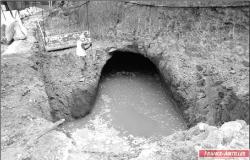 Fort de France - L'ouvrage découvert sous le boulevard Maurice-Bishop à l'entrée du bassin de Radoub serait une canalisation de la fin du XVIIIe siècle, destinée à évacuer les eaux, selon les premières explications données par Annie Noé-Dufour, conservateur régional de l'archéologie à la Direction des affaires culturelles de Martinique (Dac). Cette cavité découverte mercredi par les ouvriers de la Colas ?oeuvrant sur le chantier du transport en commun en site propre (TCSP), et située face au dojo, s'étend sur une quinzaine de mètres, selon les premières estimations fournies par les ouvriers qui y sont descendu. Le site inondé aux trois quarts, n'a cependant pas permis d'aller très loin en profondeur. Quoi qu'il en soit, cette découverte inattendue a entraîné l'arrêt provisoire des travaux.
Fort de France - L'ouvrage découvert sous le boulevard Maurice-Bishop à l'entrée du bassin de Radoub serait une canalisation de la fin du XVIIIe siècle, destinée à évacuer les eaux, selon les premières explications données par Annie Noé-Dufour, conservateur régional de l'archéologie à la Direction des affaires culturelles de Martinique (Dac). Cette cavité découverte mercredi par les ouvriers de la Colas ?oeuvrant sur le chantier du transport en commun en site propre (TCSP), et située face au dojo, s'étend sur une quinzaine de mètres, selon les premières estimations fournies par les ouvriers qui y sont descendu. Le site inondé aux trois quarts, n'a cependant pas permis d'aller très loin en profondeur. Quoi qu'il en soit, cette découverte inattendue a entraîné l'arrêt provisoire des travaux.
http://www.martinique.franceantilles.fr/actualite/vielocale/tcsp-un-tunnel-nous-plonge-dans-l-histoire-de-la-capitale-172948.php
BULGARIE - Via Pontica - Archaeological excavations are starting at the last four archaeological sites under the Via Pontica programme along Bulgaria’s Black Sea coast, National History Museum head Bozhidar Dimitrov said on September 10 2012. Work on the archaeological digs in the government’s Via Pontica programme was delayed because each site is in a summer resort and the work might have been inconvenient for tourists, Dimitrov told local news agency Focus. Now that most of the summer’s tourists have left Bulgaria, it was possible to start the underwater archaeological excavations of Akra fortress close to the town of Chernomorets, the excavations of the Northern Tower – a big feudal castle on the northern coast of the Old Town in Sozopol, archeological excavations in Urdoviza fortress in the town of Kiten and archeological excavations in a fortress in the village of Sinemorets, on the hill above the mouth of the Veleka river. The archeologists are already reporting the first results, Dimitrov said. Close to Akra fortress a port settlement was found separately from the fortified town. It existed for nearly 1000 years, according to the report. Amphorae and construction ceramics dating back to the fifth century BCE to the sixth century CE were found in at the site. A large feudal tower was discovered in the town of Sozopol. It is fortified with buttresses in the “most picturesque part of the town,” Dimitrov said.
http://sofiaglobe.com/2012/09/10/archaeology-excavations-start-at-last-four-archeological-sites-under-via-pontica-programme-in-bulgaria/
ISRAEL – Jaffa - The Old Testament Studies and Biblical Archaeology division of the Faculty of Protestant Theology at Johannes Gutenberg University Mainz (JGU) and the University of California in Los Angeles (UCLA) this year again conducted excavations on the ancient hill of Jaffa in Israel. The recent excavations have not only shed new light on the destruction of elements of the fortification, but also unearthed evidence pointing towards the presence of an Egyptian population on the site. Historically, Jaffa, now part of the city of Tel Aviv, is the oldest port documented in world history. Ever since the 2nd millennium B.C., Jaffa has been home to intense trading activity. The remains of a gateway belonging to an Egyptian fortification dating to the dynasty of Ramses II (1279-1213 B.C.) had already been discovered during excavations led by the former municipal archaeologist Y. Kaplan in the 1950s. However, the findings from Kaplan's digs have never been extensively published. The goal of this year's excavations was to clarify the history of settlement during the 2nd millennium B.C. by investigating the phases of the fort's destruction and the nature of the Egyptian presence. The German site director Dr. Martin Peilstöcker of JGU explains that it has now become clear that the gate itself was destroyed and rebuilt at least four times. Moreover, it also appears that there is more than just the mud brick architecture and household pottery that reflect Egyptian tradition. In fact, a rare scarab amulet has been found that bears the cartouche of the Egyptian Pharaoh Amenhotep III (1390-1353 B.C.), thus also attesting to the presence of an Egyptian community in the city.
http://esciencenews.com/articles/2012/09/10/excavations.jaffa.confirm.presence.egyptian.settlement.ancient.city.site
CANADA – 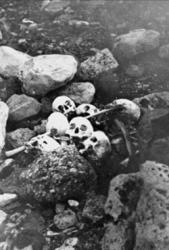 King William Island - Archeologists involved in the hunt for the wreckage of the Franklin Expedition in Canada's Arctic have discovered human remains they believe are from a member of the doomed crew. At Erebus Bay, where at least a dozen members of the Franklin crew are known to have died, more human remains have been recovered. "They did find a human tooth, and some bone and a toothbrush," Bernier said. "These were really exciting finds." Sir John Franklin set out from England on May 19, 1845, on a mission to find the Northwest Passage through the Arctic. He had two Royal Navy ships — the HMS Erebus and the HMS Terror — a crew of 135, and provisions for what was expected to be a three-year journey. In August 1845, two European whaling ships had a chance meeting with the Franklin Expedition as they waited to cross Baffin Bay to Lancaster Sound. That would be their last contact with the outside world. In 1859, a search party hired by Lady Jane Franklin found a message left in a cairn on Victory Point, King William Island. The ships had become trapped in the ice in Victoria Strait in late 1846, and remained there for a year and a half.,The message said Sir John Franklin died on June 11, 1847, and by the following spring another 24 members of the crew had perished. In April 1848 the rest of the crew left a note saying they were to set out on foot, for a destination they would never reach. There have been many efforts to find the lost ships, to no avail.
King William Island - Archeologists involved in the hunt for the wreckage of the Franklin Expedition in Canada's Arctic have discovered human remains they believe are from a member of the doomed crew. At Erebus Bay, where at least a dozen members of the Franklin crew are known to have died, more human remains have been recovered. "They did find a human tooth, and some bone and a toothbrush," Bernier said. "These were really exciting finds." Sir John Franklin set out from England on May 19, 1845, on a mission to find the Northwest Passage through the Arctic. He had two Royal Navy ships — the HMS Erebus and the HMS Terror — a crew of 135, and provisions for what was expected to be a three-year journey. In August 1845, two European whaling ships had a chance meeting with the Franklin Expedition as they waited to cross Baffin Bay to Lancaster Sound. That would be their last contact with the outside world. In 1859, a search party hired by Lady Jane Franklin found a message left in a cairn on Victory Point, King William Island. The ships had become trapped in the ice in Victoria Strait in late 1846, and remained there for a year and a half.,The message said Sir John Franklin died on June 11, 1847, and by the following spring another 24 members of the crew had perished. In April 1848 the rest of the crew left a note saying they were to set out on foot, for a destination they would never reach. There have been many efforts to find the lost ships, to no avail.
http://www.680news.com/news/national/article/399740--bones-artifacts-found-from-franklin-expedition-but-so-far-no-ships